Panda Restaurant Group Bundle
How Did Panda Restaurant Group Conquer the American Palate?
From a single restaurant to a global empire, Panda Restaurant Group's story is a testament to strategic vision and culinary adaptation. Founded in 1973, the company, initially known as Panda Inn, revolutionized the fast-casual dining scene with its innovative take on Chinese-American cuisine. This journey reveals how a simple idea transformed into a dominant force in the quick service restaurants landscape.
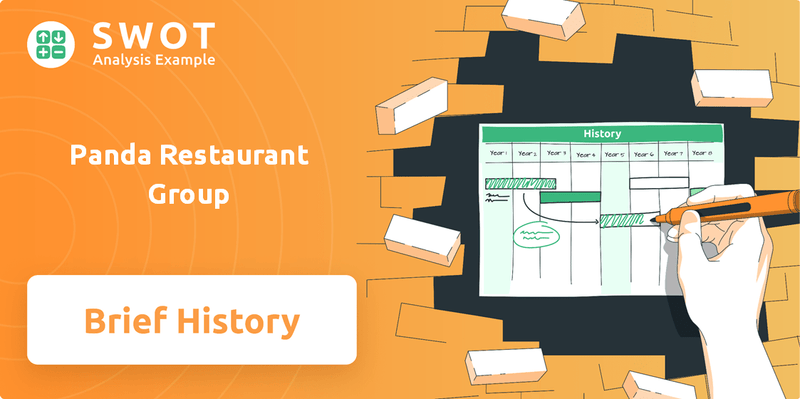
Delving into the brief history of Panda Express, we uncover the key decisions that fueled its remarkable growth. Understanding the Panda Restaurant Group SWOT Analysis provides deeper insights into its strategic moves. Learn about the Panda Inn restaurant history and how it paved the way for the widespread popularity of Panda Express and its evolution in the Chinese food restaurants sector. This exploration will illuminate the company's journey from its early years to its current status as a leading fast casual dining chain.
What is the Panda Restaurant Group Founding Story?
The story of Panda Restaurant Group, a prominent player in the quick service restaurants industry, began on June 8, 1973, with the opening of Panda Inn in Pasadena, California. This marked the inception of what would become a significant force in the realm of Chinese food restaurants. The founders, Andrew Cherng and his father, Master Chef Ming-Tsai Cherng, set out to redefine the perception of Chinese-American cuisine.
Andrew Cherng, who brought with him a deep understanding of Chinese culinary traditions, teamed up with his father, a skilled chef, to introduce a more authentic and diverse range of flavors. Their vision was to offer high-quality, gourmet Chinese cuisine in a welcoming, sit-down environment, a departure from the typical chop suey offerings prevalent at the time. The initial focus was on a full-service dining experience.
The early days of Panda Inn were characterized by bootstrapping, with the Cherng family pooling their resources and securing loans to establish the restaurant. The name 'Panda' was chosen to evoke a sense of familiarity and friendliness, while also being distinctly Asian. The success of Panda Inn proved the viability of their vision, laying the groundwork for future expansion and the eventual evolution into the Panda Express chain.
Panda Inn, the precursor to Panda Express, was founded in 1973. It aimed to offer a more authentic Chinese dining experience.
- The founders, Andrew Cherng and his father, Master Chef Ming-Tsai Cherng, brought their culinary expertise to the forefront.
- The initial funding was primarily through family resources and loans.
- The name 'Panda' was selected for its friendly and Asian-associated appeal.
- The success of Panda Inn paved the way for the future growth of the restaurant group.
The journey of Panda Restaurant Group, from its humble beginnings as Panda Inn to its current status, is a testament to the vision and dedication of its founders. For a deeper dive into the company's strategic growth, consider reading about the Growth Strategy of Panda Restaurant Group.
Panda Restaurant Group SWOT Analysis
- Complete SWOT Breakdown
- Fully Customizable
- Editable in Excel & Word
- Professional Formatting
- Investor-Ready Format
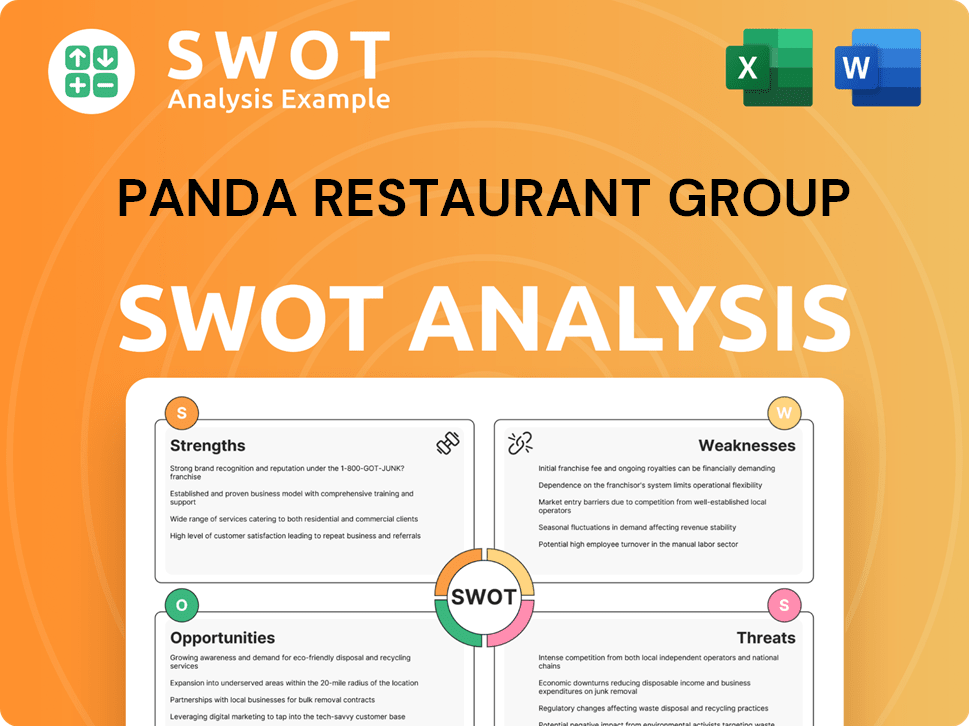
What Drove the Early Growth of Panda Restaurant Group?
Following the success of Panda Inn, the founders of Panda Restaurant Group were approached to create a fast-food version of their restaurant. This led to the opening of the first Panda Express in Glendale, California, in October 1983. This strategic shift to a fast-casual model was a key decision in the company's early growth and expansion.
The initial product launches for Panda Express focused on popular American Chinese dishes, with Orange Chicken becoming a signature item. Early expansion involved building an operational staff to support the growing number of food court locations. This marked a significant step in the Mission, Vision & Core Values of Panda Restaurant Group.
Panda Express expanded rapidly, mainly within shopping mall food courts across California and then nationwide. By 1985, there were five locations, and by 1991, the chain had grown to 20 locations. This growth was fueled by the rising popularity of fast-casual dining and the consistent quality of the food.
The company strategically focused on high-traffic locations to ensure visibility and accessibility. This period also saw the establishment of robust operational systems to support the expanding restaurants. These systems included supply chain management and employee training programs to maintain quality.
The market reception was overwhelmingly positive, as Panda Express filled a niche for accessible, flavorful, and relatively quick Chinese-American food. This differentiated it from both traditional sit-down Chinese restaurants and other fast-food options. The focus on fast casual dining helped Panda Express become a leading brand in Chinese food restaurants.
Panda Restaurant Group PESTLE Analysis
- Covers All 6 PESTLE Categories
- No Research Needed – Save Hours of Work
- Built by Experts, Trusted by Consultants
- Instant Download, Ready to Use
- 100% Editable, Fully Customizable
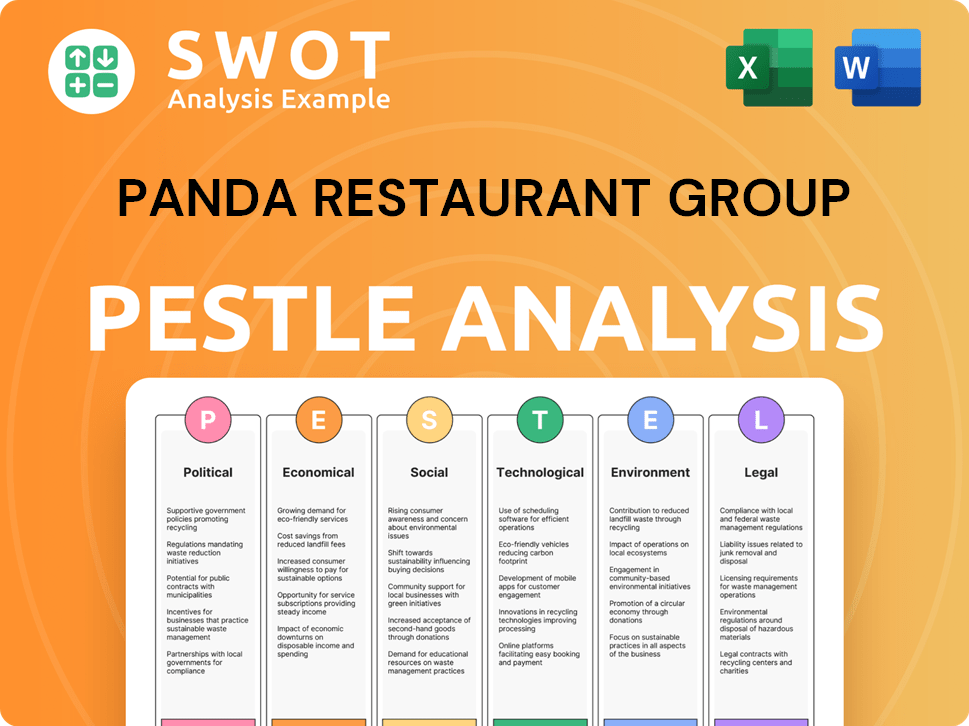
What are the key Milestones in Panda Restaurant Group history?
The story of Panda Restaurant Group, encompassing both Panda Express and Panda Inn, is marked by significant achievements and expansions. The company's journey includes key moments that have shaped its presence in the fast casual dining sector. From its beginnings to its current status, the company has consistently adapted and evolved.
| Year | Milestone |
|---|---|
| 1973 | Panda Inn, the first full-service restaurant, was established in Pasadena, California. |
| 1983 | Panda Express, a quick-service concept, was launched, beginning in a food court in a shopping mall. |
| 1987 | The introduction of Orange Chicken, which became a signature dish, occurred. |
| 1992 | Panda Express opened its first location outside of California. |
| 2017 | Panda Express opened its first location in Canada. |
| 2023 | Panda Express celebrated its 40th anniversary. |
Innovation has been a key driver for Panda Restaurant Group's success, particularly in how it presents and evolves its menu. The company has consistently sought to enhance the dining experience through its offerings and operational strategies. This includes adapting to changing consumer preferences and technological advancements.
Panda Express has continuously updated its menu to include healthier options and customizable bowls. This approach caters to diverse dietary needs and preferences, ensuring relevance in the market.
The company pioneered the concept of 'wok-fired' dishes in a fast-casual setting, emphasizing freshness and flavor. This cooking method has become a hallmark of the brand, setting it apart from competitors.
Panda Express has invested heavily in technology, enhancing its online ordering and delivery capabilities. This adaptation to the digital age has improved customer convenience and operational efficiency.
Major partnerships included collaborations with Disney theme parks and various universities, expanding their reach beyond traditional mall food courts. These partnerships helped to increase brand visibility and customer base.
Panda Restaurant Group has received numerous recognitions for its operational excellence and customer service. These awards reflect the company's commitment to quality and customer satisfaction.
Internally, the company has emphasized its unique 'Panda Culture,' focusing on continuous learning and employee development. This focus helps maintain consistency across its vast network of restaurants.
Panda Restaurant Group has faced challenges common in the fast-casual dining industry, including intense competition and changing consumer preferences. The company has addressed these issues through strategic menu adjustments, technological advancements, and a focus on customer experience.
The fast-casual dining sector is highly competitive, requiring constant innovation and adaptation. Panda Express has to continuously differentiate itself to maintain market share.
Shifting consumer preferences towards healthier options have led to menu adjustments. The company has responded by introducing lighter options and customizable bowls.
During economic downturns, Panda Restaurant Group maintained its value proposition, offering affordable and satisfying meals. This strategy helped retain customers during challenging times.
Like many restaurants, Panda Express has faced supply chain disruptions, which have impacted ingredient availability and costs. The company has had to adapt its sourcing strategies.
The restaurant industry faces challenges in the labor market, including staffing shortages and rising labor costs. Panda Express has implemented strategies to attract and retain employees.
Expanding the menu to meet diverse needs can increase operational complexity. Panda Express carefully manages its menu to balance variety with efficiency.
Panda Restaurant Group Business Model Canvas
- Complete 9-Block Business Model Canvas
- Effortlessly Communicate Your Business Strategy
- Investor-Ready BMC Format
- 100% Editable and Customizable
- Clear and Structured Layout
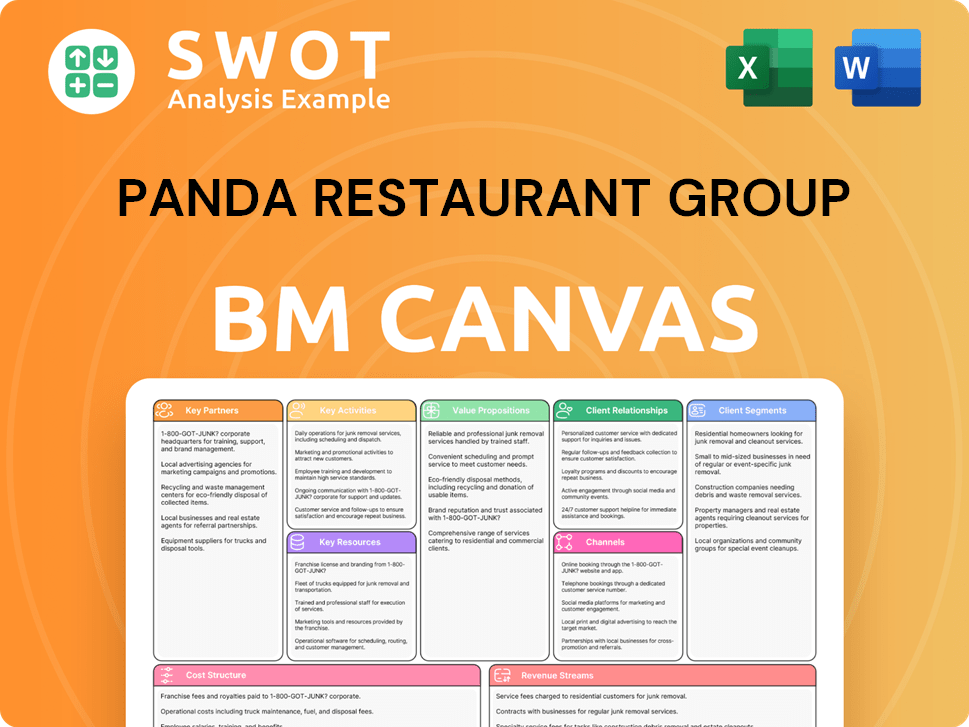
What is the Timeline of Key Events for Panda Restaurant Group?
The Competitors Landscape of Panda Restaurant Group began in 1973 when Andrew and Ming-Tsai Cherng opened the first Panda Inn in Pasadena, California. This marked the genesis of the Panda Restaurant Group. The company then evolved significantly with the launch of Panda Express in 1983, pioneering the fast-casual American Chinese concept. Over the years, Panda Express has expanded rapidly, introducing iconic dishes like Orange Chicken in 1987 and opening its first drive-thru in 1992. The company reached its 100th location in 1993 and expanded internationally in 1998. By 2017, Panda Express had opened its 2,000th location, and in 2024, it operates over 2,500 locations globally.
| Year | Key Event |
|---|---|
| 1973 | Andrew and Ming-Tsai Cherng opened the first Panda Inn in Pasadena, California. |
| 1983 | The first Panda Express opened in Glendale, California, establishing the fast-casual American Chinese concept. |
| 1987 | Orange Chicken was introduced to the Panda Express menu, quickly becoming a signature dish. |
| 1992 | Panda Express opened its first drive-thru location. |
| 1993 | Panda Express opened its 100th location. |
| 1998 | The company expanded internationally, opening its first restaurant in Mexico. |
| 2005 | Panda Express opened its 500th location. |
| 2007 | Panda Restaurant Group launched the Panda Cares Foundation, its philanthropic arm. |
| 2010s | Significant expansion in non-traditional venues like airports, universities, and hospitals. |
| 2017 | Panda Express opened its 2,000th location. |
| 2020s | Continued focus on digital transformation, including enhanced online ordering and delivery services. |
| 2024 | Panda Express operates over 2,500 locations globally. |
Panda Restaurant Group plans further international expansion, targeting markets with a growing appetite for American Chinese cuisine. This strategic move aims to capitalize on the global demand for diverse culinary experiences. The company is likely to focus on regions where the brand can gain a significant market share, building on its existing international presence.
The company is investing in technology to enhance the customer experience, including AI-driven personalized ordering and improved delivery systems. These advancements will streamline operations and cater to the increasing demand for convenience. Digital transformation will play a crucial role in maintaining a competitive edge in the quick service restaurants sector.
Panda Express is expected to adapt its menu to meet evolving dietary preferences and explore new restaurant formats. This includes offering healthier options and catering to various dietary needs. The company's ability to innovate and adapt will be key to its long-term success in the competitive Chinese food restaurants market.
Industry trends toward sustainability and community engagement will influence Panda Restaurant Group's future direction. The company is likely to focus on sustainable practices and strengthen its community involvement. These initiatives will enhance its brand reputation and appeal to environmentally conscious consumers.
Panda Restaurant Group Porter's Five Forces Analysis
- Covers All 5 Competitive Forces in Detail
- Structured for Consultants, Students, and Founders
- 100% Editable in Microsoft Word & Excel
- Instant Digital Download – Use Immediately
- Compatible with Mac & PC – Fully Unlocked
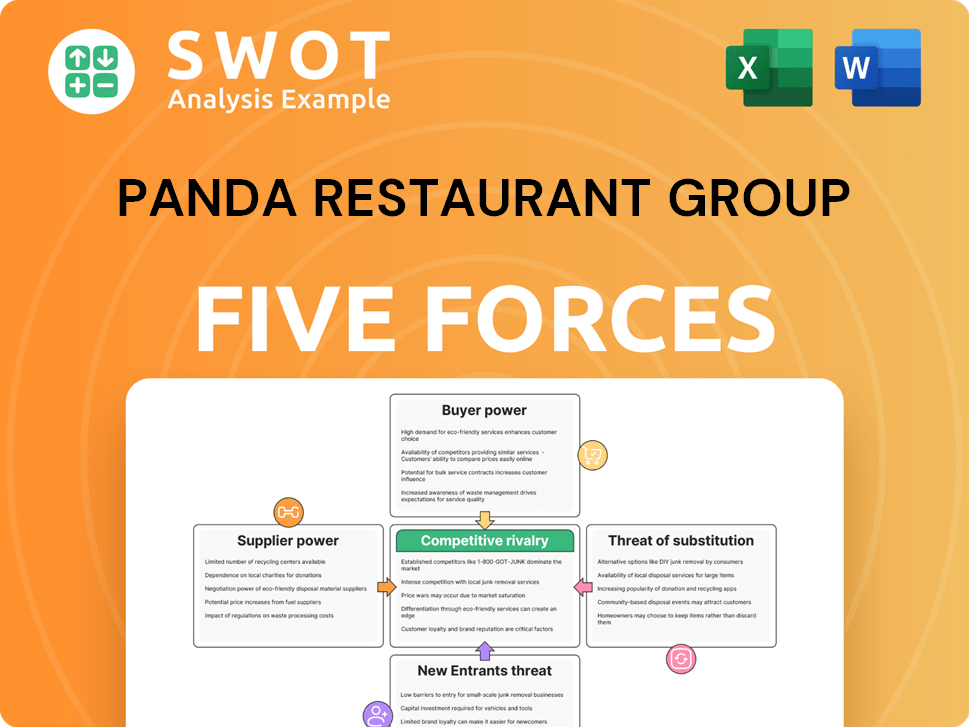
Related Blogs
- What is Competitive Landscape of Panda Restaurant Group Company?
- What is Growth Strategy and Future Prospects of Panda Restaurant Group Company?
- How Does Panda Restaurant Group Company Work?
- What is Sales and Marketing Strategy of Panda Restaurant Group Company?
- What is Brief History of Panda Restaurant Group Company?
- Who Owns Panda Restaurant Group Company?
- What is Customer Demographics and Target Market of Panda Restaurant Group Company?
Disclaimer
All information, articles, and product details provided on this website are for general informational and educational purposes only. We do not claim any ownership over, nor do we intend to infringe upon, any trademarks, copyrights, logos, brand names, or other intellectual property mentioned or depicted on this site. Such intellectual property remains the property of its respective owners, and any references here are made solely for identification or informational purposes, without implying any affiliation, endorsement, or partnership.
We make no representations or warranties, express or implied, regarding the accuracy, completeness, or suitability of any content or products presented. Nothing on this website should be construed as legal, tax, investment, financial, medical, or other professional advice. In addition, no part of this site—including articles or product references—constitutes a solicitation, recommendation, endorsement, advertisement, or offer to buy or sell any securities, franchises, or other financial instruments, particularly in jurisdictions where such activity would be unlawful.
All content is of a general nature and may not address the specific circumstances of any individual or entity. It is not a substitute for professional advice or services. Any actions you take based on the information provided here are strictly at your own risk. You accept full responsibility for any decisions or outcomes arising from your use of this website and agree to release us from any liability in connection with your use of, or reliance upon, the content or products found herein.